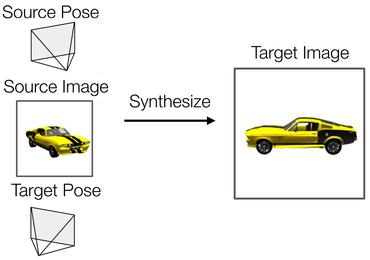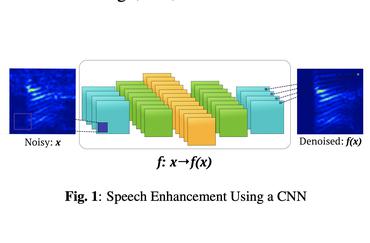Search Results for author: Richard Zhang
Found 55 papers, 38 papers with code
Aligning and Projecting Images to Class-conditional Generative Networks
no code implementations • ECCV 2020 • Minyoung Huh, Richard Zhang, Jun-Yan Zhu, Sylvain Paris, Aaron Hertzmann
We present a method for projecting an input image into the space of a class-conditional generative neural network.
Improved Distribution Matching Distillation for Fast Image Synthesis
no code implementations • 23 May 2024 • Tianwei Yin, Michaël Gharbi, Taesung Park, Richard Zhang, Eli Shechtman, Fredo Durand, William T. Freeman
Recent approaches have shown promises distilling diffusion models into efficient one-step generators.
Personalized Residuals for Concept-Driven Text-to-Image Generation
no code implementations • 21 May 2024 • Cusuh Ham, Matthew Fisher, James Hays, Nicholas Kolkin, Yuchen Liu, Richard Zhang, Tobias Hinz
We present personalized residuals and localized attention-guided sampling for efficient concept-driven generation using text-to-image diffusion models.
Distilling Diffusion Models into Conditional GANs
no code implementations • 9 May 2024 • Minguk Kang, Richard Zhang, Connelly Barnes, Sylvain Paris, Suha Kwak, Jaesik Park, Eli Shechtman, Jun-Yan Zhu, Taesung Park
We propose a method to distill a complex multistep diffusion model into a single-step conditional GAN student model, dramatically accelerating inference, while preserving image quality.
Editable Image Elements for Controllable Synthesis
no code implementations • 24 Apr 2024 • Jiteng Mu, Michaël Gharbi, Richard Zhang, Eli Shechtman, Nuno Vasconcelos, Xiaolong Wang, Taesung Park
In this work, we propose an image representation that promotes spatial editing of input images using a diffusion model.
Lazy Diffusion Transformer for Interactive Image Editing
no code implementations • 18 Apr 2024 • Yotam Nitzan, Zongze Wu, Richard Zhang, Eli Shechtman, Daniel Cohen-Or, Taesung Park, Michaël Gharbi
We demonstrate that our approach is competitive with state-of-the-art inpainting methods in terms of quality and fidelity while providing a 10x speedup for typical user interactions, where the editing mask represents 10% of the image.
VideoGigaGAN: Towards Detail-rich Video Super-Resolution
no code implementations • 18 Apr 2024 • Yiran Xu, Taesung Park, Richard Zhang, Yang Zhou, Eli Shechtman, Feng Liu, Jia-Bin Huang, Difan Liu
We introduce VideoGigaGAN, a new generative VSR model that can produce videos with high-frequency details and temporal consistency.
Customizing Text-to-Image Diffusion with Camera Viewpoint Control
no code implementations • 18 Apr 2024 • Nupur Kumari, Grace Su, Richard Zhang, Taesung Park, Eli Shechtman, Jun-Yan Zhu
Model customization introduces new concepts to existing text-to-image models, enabling the generation of the new concept in novel contexts.
Jump Cut Smoothing for Talking Heads
no code implementations • 9 Jan 2024 • Xiaojuan Wang, Taesung Park, Yang Zhou, Eli Shechtman, Richard Zhang
We leverage the appearance of the subject from the other source frames in the video, fusing it with a mid-level representation driven by DensePose keypoints and face landmarks.
Customizing Motion in Text-to-Video Diffusion Models
no code implementations • 7 Dec 2023 • Joanna Materzynska, Josef Sivic, Eli Shechtman, Antonio Torralba, Richard Zhang, Bryan Russell
To avoid overfitting to the new custom motion, we introduce an approach for regularization over videos.
One-step Diffusion with Distribution Matching Distillation
1 code implementation • 30 Nov 2023 • Tianwei Yin, Michaël Gharbi, Richard Zhang, Eli Shechtman, Fredo Durand, William T. Freeman, Taesung Park
We introduce Distribution Matching Distillation (DMD), a procedure to transform a diffusion model into a one-step image generator with minimal impact on image quality.
Online Detection of AI-Generated Images
no code implementations • 23 Oct 2023 • David C. Epstein, Ishan Jain, Oliver Wang, Richard Zhang
With advancements in AI-generated images coming on a continuous basis, it is increasingly difficult to distinguish traditionally-sourced images (e. g., photos, artwork) from AI-generated ones.
Evaluating Data Attribution for Text-to-Image Models
1 code implementation • ICCV 2023 • Sheng-Yu Wang, Alexei A. Efros, Jun-Yan Zhu, Richard Zhang
The problem of data attribution in such models -- which of the images in the training set are most responsible for the appearance of a given generated image -- is a difficult yet important one.
DreamSim: Learning New Dimensions of Human Visual Similarity using Synthetic Data
1 code implementation • NeurIPS 2023 • Stephanie Fu, Netanel Tamir, Shobhita Sundaram, Lucy Chai, Richard Zhang, Tali Dekel, Phillip Isola
Furthermore, our metric outperforms both prior learned metrics and recent large vision models on these tasks.
Ablating Concepts in Text-to-Image Diffusion Models
1 code implementation • ICCV 2023 • Nupur Kumari, Bingliang Zhang, Sheng-Yu Wang, Eli Shechtman, Richard Zhang, Jun-Yan Zhu
To achieve this goal, we propose an efficient method of ablating concepts in the pretrained model, i. e., preventing the generation of a target concept.
Scaling up GANs for Text-to-Image Synthesis
1 code implementation • CVPR 2023 • Minguk Kang, Jun-Yan Zhu, Richard Zhang, Jaesik Park, Eli Shechtman, Sylvain Paris, Taesung Park
From a technical standpoint, it also marked a drastic change in the favored architecture to design generative image models.
 Ranked #18 on
Image Generation
on ImageNet 256x256
Ranked #18 on
Image Generation
on ImageNet 256x256
Zero-shot Image-to-Image Translation
2 code implementations • 6 Feb 2023 • Gaurav Parmar, Krishna Kumar Singh, Richard Zhang, Yijun Li, Jingwan Lu, Jun-Yan Zhu
However, it is still challenging to directly apply these models for editing real images for two reasons.
 Ranked #13 on
Text-based Image Editing
on PIE-Bench
Ranked #13 on
Text-based Image Editing
on PIE-Bench
Domain Expansion of Image Generators
1 code implementation • CVPR 2023 • Yotam Nitzan, Michaël Gharbi, Richard Zhang, Taesung Park, Jun-Yan Zhu, Daniel Cohen-Or, Eli Shechtman
First, we note the generator contains a meaningful, pretrained latent space.
Multi-Concept Customization of Text-to-Image Diffusion
2 code implementations • CVPR 2023 • Nupur Kumari, Bingliang Zhang, Richard Zhang, Eli Shechtman, Jun-Yan Zhu
Can we teach a model to quickly acquire a new concept, given a few examples?
3D-FM GAN: Towards 3D-Controllable Face Manipulation
no code implementations • 24 Aug 2022 • Yuchen Liu, Zhixin Shu, Yijun Li, Zhe Lin, Richard Zhang, S. Y. Kung
While concatenating GAN inversion and a 3D-aware, noise-to-image GAN is a straight-forward solution, it is inefficient and may lead to noticeable drop in editing quality.
Spatially-Adaptive Multilayer Selection for GAN Inversion and Editing
1 code implementation • CVPR 2022 • Gaurav Parmar, Yijun Li, Jingwan Lu, Richard Zhang, Jun-Yan Zhu, Krishna Kumar Singh
We propose a new method to invert and edit such complex images in the latent space of GANs, such as StyleGAN2.
ASSET: Autoregressive Semantic Scene Editing with Transformers at High Resolutions
1 code implementation • 24 May 2022 • Difan Liu, Sandesh Shetty, Tobias Hinz, Matthew Fisher, Richard Zhang, Taesung Park, Evangelos Kalogerakis
We present ASSET, a neural architecture for automatically modifying an input high-resolution image according to a user's edits on its semantic segmentation map.
BlobGAN: Spatially Disentangled Scene Representations
no code implementations • 5 May 2022 • Dave Epstein, Taesung Park, Richard Zhang, Eli Shechtman, Alexei A. Efros
Blobs are differentiably placed onto a feature grid that is decoded into an image by a generative adversarial network.
Any-resolution Training for High-resolution Image Synthesis
1 code implementation • 14 Apr 2022 • Lucy Chai, Michael Gharbi, Eli Shechtman, Phillip Isola, Richard Zhang
To take advantage of varied-size data, we introduce continuous-scale training, a process that samples patches at random scales to train a new generator with variable output resolutions.
Ensembling Off-the-shelf Models for GAN Training
1 code implementation • CVPR 2022 • Nupur Kumari, Richard Zhang, Eli Shechtman, Jun-Yan Zhu
Can the collective "knowledge" from a large bank of pretrained vision models be leveraged to improve GAN training?
 Ranked #1 on
Image Generation
on AFHQ Cat
Ranked #1 on
Image Generation
on AFHQ Cat
GAN-Supervised Dense Visual Alignment
1 code implementation • CVPR 2022 • William Peebles, Jun-Yan Zhu, Richard Zhang, Antonio Torralba, Alexei A. Efros, Eli Shechtman
We propose GAN-Supervised Learning, a framework for learning discriminative models and their GAN-generated training data jointly end-to-end.
Preconditioned Gradient Descent for Over-Parameterized Nonconvex Matrix Factorization
no code implementations • NeurIPS 2021 • Jialun Zhang, Salar Fattahi, Richard Zhang
This over-parameterized regime of matrix factorization significantly slows down the convergence of local search algorithms, from a linear rate with $r=r^{\star}$ to a sublinear rate when $r>r^{\star}$.
Contrastive Feature Loss for Image Prediction
1 code implementation • 12 Nov 2021 • Alex Andonian, Taesung Park, Bryan Russell, Phillip Isola, Jun-Yan Zhu, Richard Zhang
Training supervised image synthesis models requires a critic to compare two images: the ground truth to the result.
Editing Conditional Radiance Fields
1 code implementation • ICCV 2021 • Steven Liu, Xiuming Zhang, Zhoutong Zhang, Richard Zhang, Jun-Yan Zhu, Bryan Russell
In this paper, we explore enabling user editing of a category-level NeRF - also known as a conditional radiance field - trained on a shape category.
 Ranked #1 on
Novel View Synthesis
on PhotoShape
Ranked #1 on
Novel View Synthesis
on PhotoShape
Ensembling with Deep Generative Views
1 code implementation • CVPR 2021 • Lucy Chai, Jun-Yan Zhu, Eli Shechtman, Phillip Isola, Richard Zhang
Here, we investigate whether such views can be applied to real images to benefit downstream analysis tasks such as image classification.
On Aliased Resizing and Surprising Subtleties in GAN Evaluation
3 code implementations • CVPR 2022 • Gaurav Parmar, Richard Zhang, Jun-Yan Zhu
Furthermore, we show that if compression is used on real training images, FID can actually improve if the generated images are also subsequently compressed.
Few-shot Image Generation via Cross-domain Correspondence
2 code implementations • CVPR 2021 • Utkarsh Ojha, Yijun Li, Jingwan Lu, Alexei A. Efros, Yong Jae Lee, Eli Shechtman, Richard Zhang
Training generative models, such as GANs, on a target domain containing limited examples (e. g., 10) can easily result in overfitting.
 Ranked #3 on
10-shot image generation
on Babies
Ranked #3 on
10-shot image generation
on Babies
The Low-Rank Simplicity Bias in Deep Networks
1 code implementation • 18 Mar 2021 • Minyoung Huh, Hossein Mobahi, Richard Zhang, Brian Cheung, Pulkit Agrawal, Phillip Isola
We show empirically that our claim holds true on finite width linear and non-linear models on practical learning paradigms and show that on natural data, these are often the solutions that generalize well.
Anycost GANs for Interactive Image Synthesis and Editing
1 code implementation • CVPR 2021 • Ji Lin, Richard Zhang, Frieder Ganz, Song Han, Jun-Yan Zhu
Generative adversarial networks (GANs) have enabled photorealistic image synthesis and editing.
CDPAM: Contrastive learning for perceptual audio similarity
1 code implementation • 9 Feb 2021 • Pranay Manocha, Zeyu Jin, Richard Zhang, Adam Finkelstein
The DPAM approach of Manocha et al. learns a full-reference metric trained directly on human judgments, and thus correlates well with human perception.
Spatially-Adaptive Pixelwise Networks for Fast Image Translation
1 code implementation • CVPR 2021 • Tamar Rott Shaham, Michael Gharbi, Richard Zhang, Eli Shechtman, Tomer Michaeli
We introduce a new generator architecture, aimed at fast and efficient high-resolution image-to-image translation.
Few-shot Image Generation with Elastic Weight Consolidation
no code implementations • NeurIPS 2020 • Yijun Li, Richard Zhang, Jingwan Lu, Eli Shechtman
Few-shot image generation seeks to generate more data of a given domain, with only few available training examples.
 Ranked #4 on
10-shot image generation
on Babies
Ranked #4 on
10-shot image generation
on Babies
How many samples is a good initial point worth in Low-rank Matrix Recovery?
no code implementations • NeurIPS 2020 • Jialun Zhang, Richard Zhang
Optimizing the threshold over regions of the landscape, we see that, for initial points not too close to the ground truth, a linear improvement in the quality of the initial guess amounts to a constant factor improvement in the sample complexity.
Contrastive Learning for Unpaired Image-to-Image Translation
10 code implementations • 30 Jul 2020 • Taesung Park, Alexei A. Efros, Richard Zhang, Jun-Yan Zhu
Furthermore, we draw negatives from within the input image itself, rather than from the rest of the dataset.
Swapping Autoencoder for Deep Image Manipulation
4 code implementations • NeurIPS 2020 • Taesung Park, Jun-Yan Zhu, Oliver Wang, Jingwan Lu, Eli Shechtman, Alexei A. Efros, Richard Zhang
Deep generative models have become increasingly effective at producing realistic images from randomly sampled seeds, but using such models for controllable manipulation of existing images remains challenging.
Transforming and Projecting Images into Class-conditional Generative Networks
2 code implementations • 4 May 2020 • Minyoung Huh, Richard Zhang, Jun-Yan Zhu, Sylvain Paris, Aaron Hertzmann
We present a method for projecting an input image into the space of a class-conditional generative neural network.
Image Morphing with Perceptual Constraints and STN Alignment
1 code implementation • 29 Apr 2020 • Noa Fish, Richard Zhang, Lilach Perry, Daniel Cohen-Or, Eli Shechtman, Connelly Barnes
In image morphing, a sequence of plausible frames are synthesized and composited together to form a smooth transformation between given instances.
A Differentiable Perceptual Audio Metric Learned from Just Noticeable Differences
1 code implementation • 13 Jan 2020 • Pranay Manocha, Adam Finkelstein, Zeyu Jin, Nicholas J. Bryan, Richard Zhang, Gautham J. Mysore
Assessment of many audio processing tasks relies on subjective evaluation which is time-consuming and expensive.
CNN-generated images are surprisingly easy to spot... for now
4 code implementations • CVPR 2020 • Sheng-Yu Wang, Oliver Wang, Richard Zhang, Andrew Owens, Alexei A. Efros
In this work we ask whether it is possible to create a "universal" detector for telling apart real images from these generated by a CNN, regardless of architecture or dataset used.
Interactive Sketch & Fill: Multiclass Sketch-to-Image Translation
1 code implementation • ICCV 2019 • Arnab Ghosh, Richard Zhang, Puneet K. Dokania, Oliver Wang, Alexei A. Efros, Philip H. S. Torr, Eli Shechtman
We propose an interactive GAN-based sketch-to-image translation method that helps novice users create images of simple objects.
Detecting Photoshopped Faces by Scripting Photoshop
2 code implementations • ICCV 2019 • Sheng-Yu Wang, Oliver Wang, Andrew Owens, Richard Zhang, Alexei A. Efros
Most malicious photo manipulations are created using standard image editing tools, such as Adobe Photoshop.
Making Convolutional Networks Shift-Invariant Again
7 code implementations • 25 Apr 2019 • Richard Zhang
The well-known signal processing fix is anti-aliasing by low-pass filtering before downsampling.
 Ranked #26 on
Domain Generalization
on VizWiz-Classification
Ranked #26 on
Domain Generalization
on VizWiz-Classification
Deep Parametric Shape Predictions using Distance Fields
1 code implementation • CVPR 2020 • Dmitriy Smirnov, Matthew Fisher, Vladimir G. Kim, Richard Zhang, Justin Solomon
Many tasks in graphics and vision demand machinery for converting shapes into consistent representations with sparse sets of parameters; these representations facilitate rendering, editing, and storage.
Stochastic Adversarial Video Prediction
4 code implementations • ICLR 2019 • Alex X. Lee, Richard Zhang, Frederik Ebert, Pieter Abbeel, Chelsea Finn, Sergey Levine
However, learning to predict raw future observations, such as frames in a video, is exceedingly challenging -- the ambiguous nature of the problem can cause a naively designed model to average together possible futures into a single, blurry prediction.
 Ranked #1 on
Video Prediction
on KTH
(Cond metric)
Ranked #1 on
Video Prediction
on KTH
(Cond metric)
The Unreasonable Effectiveness of Deep Features as a Perceptual Metric
24 code implementations • CVPR 2018 • Richard Zhang, Phillip Isola, Alexei A. Efros, Eli Shechtman, Oliver Wang
We systematically evaluate deep features across different architectures and tasks and compare them with classic metrics.
 Ranked #19 on
Video Quality Assessment
on MSU FR VQA Database
Ranked #19 on
Video Quality Assessment
on MSU FR VQA Database
Self-Supervised Learning of Object Motion Through Adversarial Video Prediction
no code implementations • ICLR 2018 • Alex X. Lee, Frederik Ebert, Richard Zhang, Chelsea Finn, Pieter Abbeel, Sergey Levine
In this paper, we study the problem of multi-step video prediction, where the goal is to predict a sequence of future frames conditioned on a short context.
Toward Multimodal Image-to-Image Translation
6 code implementations • NeurIPS 2017 • Jun-Yan Zhu, Richard Zhang, Deepak Pathak, Trevor Darrell, Alexei A. Efros, Oliver Wang, Eli Shechtman
Our proposed method encourages bijective consistency between the latent encoding and output modes.
Real-Time User-Guided Image Colorization with Learned Deep Priors
3 code implementations • 8 May 2017 • Richard Zhang, Jun-Yan Zhu, Phillip Isola, Xinyang Geng, Angela S. Lin, Tianhe Yu, Alexei A. Efros
The system directly maps a grayscale image, along with sparse, local user "hints" to an output colorization with a Convolutional Neural Network (CNN).
Split-Brain Autoencoders: Unsupervised Learning by Cross-Channel Prediction
2 code implementations • CVPR 2017 • Richard Zhang, Phillip Isola, Alexei A. Efros
We propose split-brain autoencoders, a straightforward modification of the traditional autoencoder architecture, for unsupervised representation learning.
 Ranked #127 on
Self-Supervised Image Classification
on ImageNet
Ranked #127 on
Self-Supervised Image Classification
on ImageNet
 Representation Learning
Representation Learning
 Self-Supervised Image Classification
+1
Self-Supervised Image Classification
+1
Colorful Image Colorization
39 code implementations • 28 Mar 2016 • Richard Zhang, Phillip Isola, Alexei A. Efros
We embrace the underlying uncertainty of the problem by posing it as a classification task and use class-rebalancing at training time to increase the diversity of colors in the result.
 Ranked #128 on
Self-Supervised Image Classification
on ImageNet
Ranked #128 on
Self-Supervised Image Classification
on ImageNet























